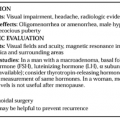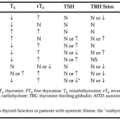DIFFERENTIATION FROM PRIMARY THYROID DYSFUNCTION
NONTHYROIDAL ILLNESS SIMULATING THYROID DYSFUNCTION
A timely distinction between the alterations in thyroid indices that are due to NTI alone and those that are related to true thyroid dysfunction is critical both to the prevention of inappropriate intervention and to the identification of patients with myxedema or thyrotoxicosis, in whom metabolic correction may have a profound influence on disease outcome. A knowledge of the previously outlined patterns of change typically seen in NTI, as well as an awareness of the pitfalls associated with strict reliance on “normal” ranges for thyroid function tests in NTI, better equips the clinician to make this distinction. Advances in serum TSH assays have greatly increased the sensitivity and specificity of these assays for detecting thyroid hormone excess and deficiency states. However, applying the normal range designed to distinguish euthyroidism from thyroid hormone excess or thyroid hormone deficiency to patients with NTI results in a loss of specificity.26 This is particularly true for patients with serum TSH values only slightly above or below the normal range. When the “euthyroid” range for serum TSH is broadened to encompass values between 0.1 and 20.0 mIU/mL in patients with NTI, the specificity of this test is enhanced to 97%.26 However, the fact that even patients with NTI who have serum TSH values that are undetectable or greater than 20 mIU/mL are still likely to be found ultimately to be euthyroid underscores the peril of relying on any single thyroid function test in these cases.26
The combined measurement of serum FT4 and TSH is prudent in patients with NTI in whom thyroid dysfunction is suspected. Although deviation from the reference range commonly occurs when either of these assays is used in patients with NTI, the concurrence of a low serum FT4 and a high TSH (“hypothy-roid” pattern) or of a high serum FT4 and a low TSH (“hyperthyroid” pattern) is distinctly uncommon as a manifestation of NTI alone5,68 (Fig. 36-4). Clinicians must be familiar with the
techniques used at their institutions to measure or to estimate FT4. Indices, as well as analog methodologies, are likely to underestimate serum FT4 values during NTI. Newer, simplified methods for measuring FT4 by direct equilibrium dialysis should provide the needed supplement to a sensitive TSH assay in this setting. For patients for whom diagnostic uncertainty remains, the measurement of significant antibody titers against thyroid peroxidase (microsomal antigen) appears to enhance the likelihood of finding underlying thyroid disease.26 This possibility also is greater in patients who are older than 60 years of age and in those who have other autoimmune disorders.15 Similarly, an abnormal TSH response to TRH further increases the likelihood that true thyroid dysfunction is present. A diagnostic approach encompassing these concepts in hospitalized patients with NTI is illustrated in Figure 36-5. A comparison of thyroid function indices found in NTI to those observed in primary hypothyroidism is provided in Table 36-2.
techniques used at their institutions to measure or to estimate FT4. Indices, as well as analog methodologies, are likely to underestimate serum FT4 values during NTI. Newer, simplified methods for measuring FT4 by direct equilibrium dialysis should provide the needed supplement to a sensitive TSH assay in this setting. For patients for whom diagnostic uncertainty remains, the measurement of significant antibody titers against thyroid peroxidase (microsomal antigen) appears to enhance the likelihood of finding underlying thyroid disease.26 This possibility also is greater in patients who are older than 60 years of age and in those who have other autoimmune disorders.15 Similarly, an abnormal TSH response to TRH further increases the likelihood that true thyroid dysfunction is present. A diagnostic approach encompassing these concepts in hospitalized patients with NTI is illustrated in Figure 36-5. A comparison of thyroid function indices found in NTI to those observed in primary hypothyroidism is provided in Table 36-2.
Stay updated, free articles. Join our Telegram channel

Full access? Get Clinical Tree





